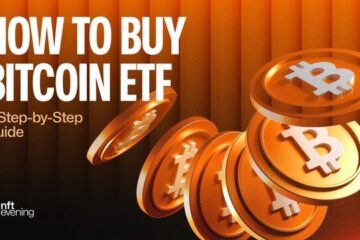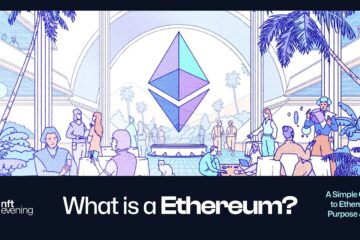Imagine owning a tiny piece of a famous piece of digital art. Sounds impossible, right? Well, thanks to ERC 404 tokens, it’s becoming a reality. This new and exciting way to own NFTs is changing the game.
Instead of buying a whole NFT, you can now buy a small part of it. This means more people can enjoy owning a piece of something special, and it makes NFTs more accessible to everyone. Learn more about what is ERC 404 tokens and how it is shaping the future of digital arts.
Key Takeaways:
- ERC 404 Token Standard allows multiple people to own parts of a single NFT, making high-value digital assets more accessible.
- By merging properties of ERC-20 and ERC-721 tokens, ERC-404 enables fractional ownership, enhancing NFT liquidity.
- The best use cases of the ERC 404 token standard include real estate, art, collectibles, gaming, and more, democratizing asset ownership and investment.
- The top ERC 404 projects on the Ethereum blockchain are $PANDARO and $DEFROGS.
What is ERC 404 Token Standard?
In simple words “ERC-404 is an experimental token standard that allows multiple people to own parts of a single NFT”.
The ERC-404 token standard is a concept on the Ethereum blockchain that aims to bridge the gap between fungible and non-fungible tokens. Unlike traditional ERC-20 tokens, which are identical and interchangeable, and ERC-721 tokens, which are unique and indivisible, ERC-404 tokens offer a hybrid approach.
The ERC-404 standard was created by two anonymous developers going under the names “ctrl” and “Acme” which merges the properties of ERC-20 and ERC-721 tokens. It also introduced the concepts of semi fungible tokens, which allow individuals to own fractions of a single NFT.
This concept opens up new possibilities for asset management and investment. For instance, high-value NFTs could become more accessible to a wider range of investors through fractional ownership. Plus, it could facilitate the creation of complex financial instruments based on NFTs.
For a better understanding, here is a quick comparison between ERC-404 vs ERC-20 vs ERC-721:
Comparison between ERC-404, 20, and 721 token standards. Source: DeFrogs
How ERC-404 Tokens Work?
ERC-404 tokens function by combining the properties of ERC-20 and ERC-721 token standards.
As discussed above, an ERC-404 token represents a fractional ownership of an NFT. When an NFT is divided into ERC-404 tokens, each token becomes a divisible unit representing a portion of the NFT. These tokens are fungible, meaning they can be traded like regular digital currencies (similar to ERC-20 tokens).
The key mechanism is the link between the ERC-404 token and the underlying NFT. When someone owns all the ERC-404 tokens associated with an NFT, they effectively own the entire NFT. This is achieved through smart contract logic that manages the relationship between the tokens and the NFT.
If someone sells part of their ERC-404 tokens, they are essentially selling a portion of their ownership of the NFT (not the entire NFT). The remaining tokens still represent ownership of the NFT. Conversely, if someone accumulates enough ERC-404 tokens, they can “burn” them to claim ownership of the entire NFT. This system allows for fractional ownership and increased liquidity for NFTs.
Working of ERC-404 Tokens. Source: Mercuryo
Use Cases of ERC-404 Token Standard
ERC-404 opens up a vast array of potential applications. Here are some prominent use cases:
- Real Estate: Expensive properties can be tokenized into ERC-404 tokens, allowing multiple individuals to own fractions. This democratizes access to real estate investments and enhances liquidity.
- Art and Collectibles: High-priced artworks or rare collectibles can be divided into ERC-404 tokens, enabling broader participation in ownership and potential price appreciation.
- Collateralization: ERC-404 tokens can serve as collateral for lending protocols, expanding the range of acceptable assets.
- Liquidity Provision: Fractional ownership of NFTs can improve liquidity by increasing the number of potential buyers and sellers
- Gaming and Metaverse: Virtual items, characters, or land within a game can be represented as ERC-404 tokens. Fractional ownership of in-game assets can create dynamic economies within virtual worlds.
- Tokenization of Assets: Real-world assets (RWAs) like commodities, bonds, or intellectual property can be tokenized and fractionalized.
- DeFi: The ERC-404 token standard expands the scope of decentralized finance (DeFi) use cases by allowing the use of non-fungible assets.
Top ERC 404 Projects
$PANDORA
Pandora, built on the ERC-404 standard, is the first project of its kind. This innovative system links 10,000 ERC-20 tokens with 10,000 “Replicant” NFTs.
When you buy a complete PANDORA token, a Replicant NFT is created and added to your wallet. If you sell a PANDORA token, the connected NFT is destroyed. These Replicant NFTs come in different rarity levels, shown by various colors, with green being the most common and red the rarest. You can change the rarity of a Replicant by trading PANDORA tokens.
$DEFROGS
DeFrogs is another project built on the experimental ERC-404 standard. It combines the characteristics of both ERC-20 and ERC-721 tokens to create a hybrid token that supports native liquidity and fractional ownership for NFTs. It also offers a collection of 10,000 unique frog profile picture NFTs. Purchasing a DeFrogs token creates a new frog NFT.
The DeFrogs project embraces the meme culture and aims to elevate the quality of meme coins and NFT art. It launched without a presale, has zero taxes, and features a locked liquidity pool. The project promotes itself as a fun and artistic endeavor, encouraging participation through humor and creativity rather than financial gain.
Rugged Art (RUG)

RUG, which created pixelated penguins, drew inspiration from the Flippies NFT collections on Solana and utilized ERC 404 token standards. This project focuses on making the ERC 404 standard adaptable with various blockchain ecosystems.
Innovative technology between rugged art and ERC 404 standard allows the collection to have NFT-FT duality. They can be traded as NFT on marketplaces and as fungible tokens on DEX.
404 Alien (404A) and Alphabet (ALPHABET) are two other projects that use ERC 404 token standards. However, their market cap and trading volume are different.
Challenges OF ERC-404 Token Standard
The ERC-404 token standard, while promising in terms of fractionalizing NFTs, faces several hurdles.
Experimental
One primary challenge is its experimental nature. As a relatively new standard, it lacks the maturity and widespread adoption of its predecessors like ERC-20 and ERC-721. This novelty means there’s a higher risk of unforeseen issues and vulnerabilities.
Liquidity Concerns
While the aim of ERC 404 is to improve liquidity for NFTs by enabling fractional ownership, a number of factors, such as user adoption, platform support, and general market conditions, will affect how liquid these tokens actually are on the market. Early projects may face liquidity issues until the standard gains more widespread use.
Technical Challenges
Another significant concern is the potential for complex interactions between the fungible and non-fungible components of ERC-404 tokens. Ensuring accurate calculations and preventing accidental burning of NFT fractions due to rounding errors is a critical technical challenge. Plus, the standard’s complexity can lead to increased NFT gas fees, making transactions more expensive.
Market Adoption
While ERC-404 offers a solution to NFT liquidity, it requires a robust ecosystem of platforms, wallets, and decentralized applications (dApps) to support its functionality. Building this infrastructure and educating users about the benefits of fractional ownership will take time.
Regulations
Regulatory uncertainty looms large over the ERC-404 standard. As fractional ownership introduces new financial dynamics, regulators may need to develop specific guidelines for these types of assets. Navigating this regulatory landscape could be challenging for projects and users alike.
Untested
Finally, the ERC-404 standard hasn’t undergone the rigorous review process of Ethereum Improvement Proposals (EIPs). This lack of formal standardization could hinder its long-term acceptance and raise questions about its security and reliability.
Future of ERC-404 Tokens
One of the most promising aspects is the potential for wider adoption. As more people become familiar with fractional ownership and the benefits it offers, the demand for ERC-404 tokens is likely to grow. This increased adoption could lead to a more liquid market, making it easier to buy and sell fractional NFT shares.
ERC-404 could also pave the way for novel financial instruments. For instance, we might see the emergence of NFT-backed securities or derivatives. This could open up new investment opportunities and bring more traditional financial players into the NFT ecosystem.
The gaming industry is another area where ERC-404 could make a significant impact. Imagine owning a fraction of a rare in-game item or virtual real estate. This could create entirely new economic models within games and virtual worlds.
Final Thought
ERC-404 tokens are changing the way we think about NFTs. By letting people own tiny pieces of special digital items, they’re making NFTs more accessible and exciting.
While there are still things to figure out, like how to make sure everything works smoothly, the future looks bright. This new way of owning things could open up lots of cool opportunities in the world of digital art, games, and beyond.
FAQs
Is the ERC 404 token safe?
Unlike ERC 721 and ERC 20, the Ethereum Foundation does not officially recognize the ERC 404 token. The lack of through verification of the standard raises safety and integrity problems. Because of this, an ERC 404 asset will carry some risks.
How does ERC-404 token standards address security concerns?
The ERC 404 token standards would combine Ethereum’s existing security mechanisms while also proposing new techniques to combat smart contracts vulnerabilities. To assure the integrity and security of ERC-404 tokens, developers will most likely apply rigorous testing and auditing techniques similar to those used for the ERC-20 and ERC-721 standards.
What is the difference between ERC 404 and ERC 1155?
ERC 1155 supports flexible fungible tokens, such as fungible, non-fungible, and semi-fungible tokens. ERC 404 concentrates on the shift from fungible to non-fungible tokens.
Here is a quick comparison between two token standard:
| Feature | ERC-404 | ERC 1155 |
| Fungibility | Transition between fungible and non-fungible | Fungible, Non-Fungible and Semi Fungible Token. |
| Ownership | Native fractional | Collective |
| Availability | Marketplace, DeFi platforms | NFT Marketplace |
| Utility | Bridging NFT to DeFi | Gaming, ticketing, and membership |
 Bitcoin
Bitcoin  Ethereum
Ethereum  Tether
Tether  XRP
XRP  USDC
USDC  Solana
Solana  TRON
TRON  Lido Staked Ether
Lido Staked Ether  Dogecoin
Dogecoin  Figure Heloc
Figure Heloc  Cardano
Cardano  WhiteBIT Coin
WhiteBIT Coin  Bitcoin Cash
Bitcoin Cash  Wrapped stETH
Wrapped stETH  Wrapped Bitcoin
Wrapped Bitcoin  USDS
USDS  Wrapped eETH
Wrapped eETH  Binance Bridged USDT (BNB Smart Chain)
Binance Bridged USDT (BNB Smart Chain)  Chainlink
Chainlink  Monero
Monero  LEO Token
LEO Token  WETH
WETH  Zcash
Zcash  Stellar
Stellar  Hyperliquid
Hyperliquid  Coinbase Wrapped BTC
Coinbase Wrapped BTC  Ethena USDe
Ethena USDe  Litecoin
Litecoin  Sui
Sui  Avalanche
Avalanche  Hedera
Hedera  sUSDS
sUSDS  Shiba Inu
Shiba Inu  USDT0
USDT0  Dai
Dai  Canton
Canton  Uniswap
Uniswap  PayPal USD
PayPal USD  Mantle
Mantle  Cronos
Cronos  Toncoin
Toncoin  World Liberty Financial
World Liberty Financial  Ethena Staked USDe
Ethena Staked USDe  Polkadot
Polkadot  USD1
USD1  Aave
Aave  Rain
Rain  Bitget Token
Bitget Token 


